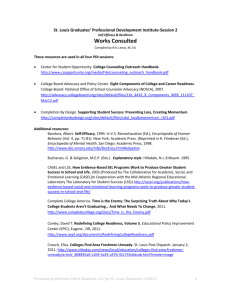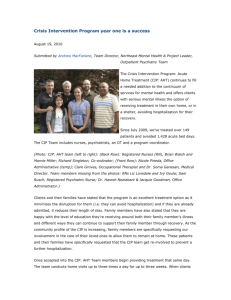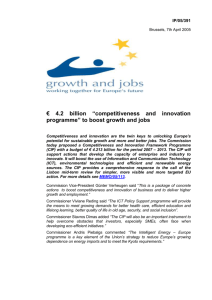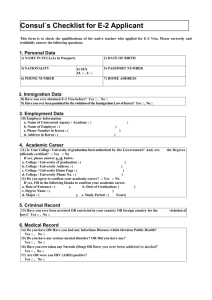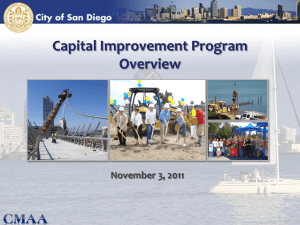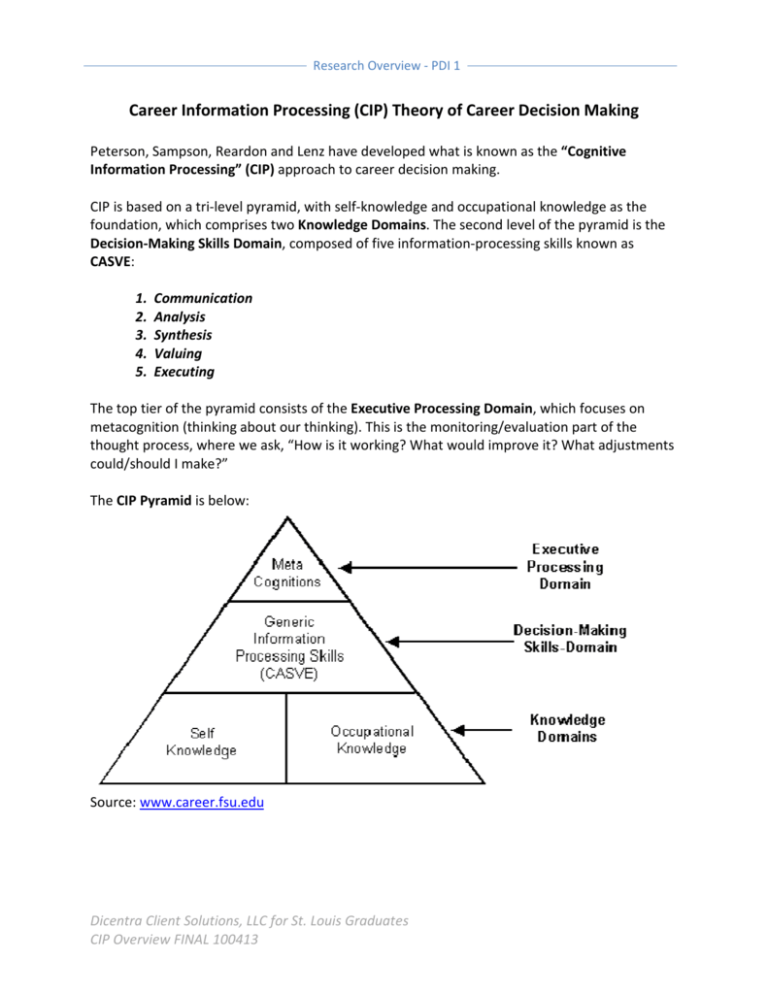
Research Overview - PDI 1
Career Information Processing (CIP) Theory of Career Decision Making
Peterson, Sampson, Reardon and Lenz have developed what is known as the “Cognitive
Information Processing” (CIP) approach to career decision making.
CIP is based on a tri-level pyramid, with self-knowledge and occupational knowledge as the
foundation, which comprises two Knowledge Domains. The second level of the pyramid is the
Decision-Making Skills Domain, composed of five information-processing skills known as
CASVE:
1.
2.
3.
4.
5.
Communication
Analysis
Synthesis
Valuing
Executing
The top tier of the pyramid consists of the Executive Processing Domain, which focuses on
metacognition (thinking about our thinking). This is the monitoring/evaluation part of the
thought process, where we ask, “How is it working? What would improve it? What adjustments
could/should I make?”
The CIP Pyramid is below:
Source: www.career.fsu.edu
Dicentra Client Solutions, LLC for St. Louis Graduates
CIP Overview FINAL 100413
Research Overview - PDI 1
Three Basic Career Information Processing Principles:
1. Self-knowledge is based on perception rather than fact, and is influenced by past
experience and present feelings (Peterson, Sampson, Reardon and Lenz).
o Understanding a person’s perceptions is an important task for college and career
counseling professionals.
2. Knowledge about occupational options is based on facts that can be verified.
“What skills are required? Where do these occupations exist? What do they pay? What
is the outlook?” (See Parsons’ “Trait & Factor Theory.”)
o College and career professionals can assist students by providing access to
current, detailed labor market information.
3. In today’s fast-paced society, decisions will need to be re-made and adjusted many
times over (See H.B. Gelatt’s “Positive Uncertainty.”)
o Teaching decision-making skills will allow students to approach inevitable
changes over the course of their career.
Six Steps to Using CASVE with Students:
1.
2.
3.
4.
5.
6.
Communication: Knowing I need to make a choice
Analysis: Understanding myself and my options
Synthesis: Expanding and narrowing my list of options
Valuing: Choosing an occupation, program of study, or job
Execution: Implementing my choice
Communication: Knowing I made a good choice
Best Practices to Employ in Using CIP-Based Processes to Assist Students
in “Getting In,” “Getting There,” and “Getting Through”:
1.
2.
3.
4.
Use of Motivational Interviewing (MI) techniques
Use of Narrative Counseling and selective assessment techniques
Identification of “red flags” and referral for services
Creation of mentoring and whole-school support models
Dicentra Client Solutions, LLC for St. Louis Graduates
CIP Overview FINAL 100413
Research Overview - PDI 1
Defining “Self-Knowledge” and
Explaining its Importance in College & Career Planning
Self-knowledge includes self-awareness of strengths, needs, interests, preferences, learning
styles, abilities, disabilities, responsibilities, rights, personality, tendencies, habits, challenges
and limitations. In college and career awareness, the goal of promoting “self-knowledge” is in
service of helping students solve problems by considering both internal and external facts.
Self-awareness is applied to decision-making, goal setting, action planning, executing the plan,
and communication.
Definitions for significant self-knowledge terms:
• Self-esteem − the positive or negative way an individual views himself or herself. It also
entails the desire to be held in high regard by others (LeFrancois, 1996).
• Self-concept − the view that an individual has of himself or herself. Notions of self are often
linked to an individual’s beliefs about how others perceive them. This is also referred to
as self-image.
• Self-actualization − the process or act of becoming oneself, developing one’s potential,
achieving an awareness of one’s identity, and fulfilling oneself. • Self-advocacy − a term that originally referred to the necessary skill of advocating for one’s
own needs, and was coined by those in the disability services fields.
• Self-determination − “the capacity to choose and to have choices – to be the decider of one’s
own actions .(Deci & Ryan, 1985).
• Identity − one’s psychological self-definition of one’s own characteristics and attributes.
• Emotional Well-being − one’s ability to relate to other people, feel comfortable with self,
cope with disappointments and stress, solve problems, celebrate successes, and make
decisions (Page & Page, 1992). Individuals must have a strong grasp of their own
emotional well-being to deal with the forms of stress and overall life changes created by
the onset of adolescence.
Emotional well-being is built upon the foundation of a positive and healthy self-esteem.
Self-esteem can be viewed as an evaluative component of self-image, and is the positive
or negative manner in which people judge themselves. It is also the degree to which an
individual sees himself or herself as competent, belonging, and worthwhile to society.
Dicentra Client Solutions, LLC for St. Louis Graduates
CIP Overview FINAL 100413
Research Overview - PDI 1
Nathaniel Branden, a preeminent psychotherapist known for his work in developing the
concept of self-esteem, said, “Apart from problems that are biological in origin, I cannot think of a single
psychological difficulty from anxiety and depression, to fear of intimacy or of success, to
alcohol or drug abuse, to underachievement at school or at work, to spouse battering or
child molestation, to sexual dysfunctions or emotional immaturity, to suicide or crimes of
violence that is not traceable to poor self-esteem. Of all of the judgments we pass, none
is as important as the one we pass on ourselves. Positive self-esteem is a cardinal
requirement of a fulfilling life” (Page & Page, 1992).
In thinking about cross-cultural communication and student self-awareness, keep in mind that
there are other factors that contribute to worldview than race and class. Geert Hofstede, in his
book, Cultures and Organizations: Software of the Mind, explains it this way:
Hofstede’s “Layers of Culture”
As almost everyone belongs to a number of different groups and categories of people at
the same time, people unavoidably carry several layers of mental programming within
themselves, corresponding to different levels of culture. For example:
•
a national level according to one's country (or countries for people who migrated
during their lifetime);
•
a regional and/or ethnic and/or religious and/or linguistic affiliation level, as
most nations are composed of culturally different regions and/or ethnic and/or
religious and/or language groups;
•
a gender level, according to whether a person was born as a girl or as a boy;
•
a generation level, which separates grandparents from parents from children;
•
a social class level, associated with educational opportunities and with a
person's occupation or profession;
•
and for those who are employed, an organizational or corporate level, according
to the way employees have been socialized by their work organization.
Dicentra Client Solutions, LLC for St. Louis Graduates
CIP Overview FINAL 100413
Research Overview - PDI 1
In working with adolescents and young adults, particular consideration needs to
be given to the cultural differences caused by generational influences.
Here are a few reminders excerpted from Beloit College’s annual “Mindset List” for the Class of
2016: (source − http://www.beloit.edu)
•
•
•
•
•
•
•
•
•
•
•
•
•
•
For this generation of entering college students, born in 1994, Kurt Cobain, Jacqueline
Kennedy Onassis, Richard Nixon and John Wayne Gacy have always been dead.
They should keep their eyes open for Justin Bieber or Dakota Fanning at freshman
orientation.
They have always lived in cyberspace, addicted to a new generation of “electronic
narcotics.”
The Biblical sources of terms such as “Forbidden Fruit,” “The Writing on the Wall,” “Good
Samaritan,” and “The Promised Land” are unknown to most of them.
If they miss The Daily Show, they can always get their news on YouTube.
Their lives have been measured in the fundamental particles of life: bits, bytes, and bauds.
Robert De Niro is thought of as Greg Focker's long-suffering father-in-law, not as Vito
Corleone or Jimmy Conway.
Bill Clinton is a senior statesman of whose presidency they have little knowledge.
They have never seen an airplane “ticket.”
On TV and in films, the ditzy dumb blonde female generally has been replaced by a couple of
Dumb and Dumber males.
The paradox "too big to fail" has been, for their generation, what "we had to destroy the
village in order to save it" was for their grandparents'.
For most of their lives, maintaining relations between the U.S. and the rest of the world has
been a woman’s job in the State Department.
They can’t picture people actually carrying luggage through airports rather than rolling it.
There has always been football in Jacksonville but never in Los Angeles.
Sources:
Deci, E. L., & Ryan, R. M. (1985). Intrinsic motivation and self-determination in human behavior.
New York: Plenum.
Gelatt, H.B. (1989). Positive uncertainty: A new decision-making framework for counseling.
Journal of Counseling Psychology, 36(2), 252-256.
Gibson, R., & Mitchell, M. (2006). Introduction to career counseling for the 21st century.
New Jersey: Pearson Prentice Hall.
Hofstede, G.H. (2005). Cultures and organizations: Software of the mind. (2nd ed.).
McGraw-Hill.
Dicentra Client Solutions, LLC for St. Louis Graduates
CIP Overview FINAL 100413
Research Overview - PDI 1
LeFrançois, G. (1996). The lifespan. New York: Wadsworth.
Page, R., & Page, T. (1992). Fostering emotional well-being in the classroom. Boston:
Jones and Bartlett.
Peterson, G. W., Sampson, J. P., Jr., Lenz, J. G., & Reardon, R. C. (2002). Becoming career
problem solvers and decision makers: A cognitive information processing approach. In
D. Brown (Ed.), Career choice and development (4th ed., pp. 312-369). San Francisco:
Jossey-Bass.
Dicentra Client Solutions, LLC for St. Louis Graduates
CIP Overview FINAL 100413

